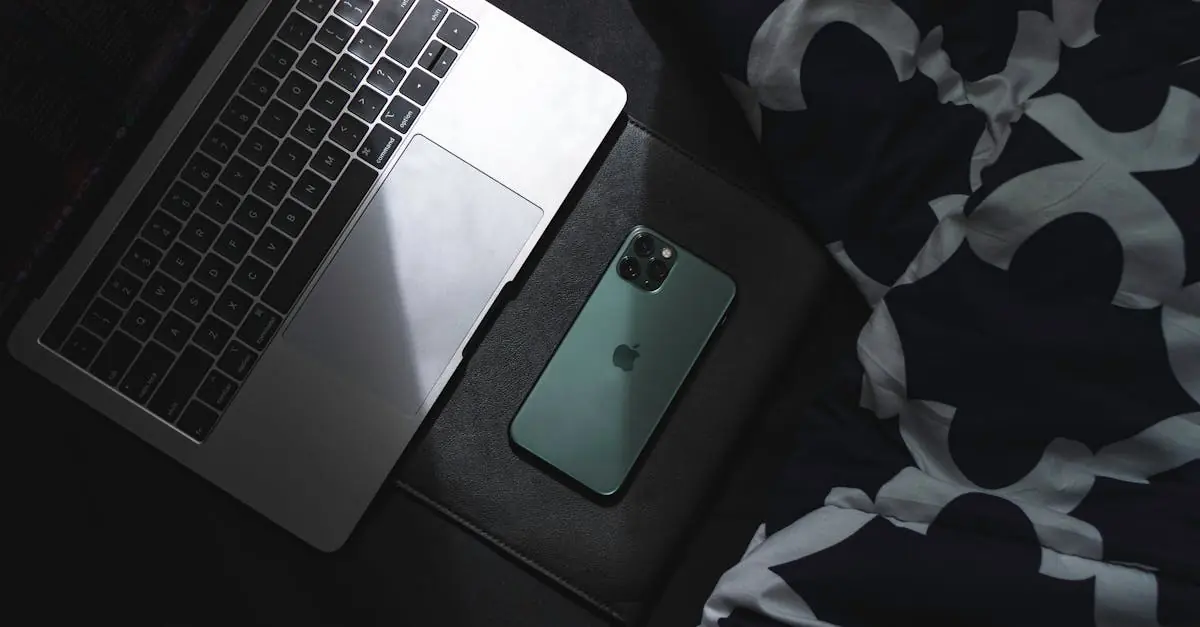Table of Contents
ToggleEver found yourself squinting at your iPhone screen while basking in the glorious sunshine? It’s like trying to read a book in a blackout—frustrating, right? While Apple’s max brightness setting is impressive, sometimes it just doesn’t cut it. Luckily, there are clever tricks to crank that brightness up beyond the limits and turn your screen into a dazzling beacon of clarity.
Understanding iPhone Screen Brightness
iPhone screen brightness plays a crucial role in user experience, especially in bright environments. Knowing how to handle brightness settings can improve visibility significantly.
Default Brightness Settings
Default brightness settings on the iPhone allow users to adjust their screens from 0 to 100 percent. At maximum brightness, many find it difficult to read under direct sunlight. Users often overlook manual adjustments found in the display settings. The option to set auto-brightness according to ambient light can also assist. For extended outdoor use, consider increasing brightness via Control Center for quick access. Some users report that toggling this option may not provide satisfaction needed in extremely bright conditions.
Adaptive Brightness Feature
Adaptive brightness is a feature that automatically adjusts screen brightness based on surrounding light. Activating this feature allows the device to optimize display settings depending on current lighting conditions. Generally, it enhances the user experience by keeping brightness comfortable for reading. However, some users may find it overly sensitive or not responsive enough. Altering the feature settings can improve specific situations, particularly in bright sunlight. Experimenting with manual settings may provide a more satisfying solution when adaptive brightness falls short.
Methods to Increase Brightness
Users seeking enhanced visibility on their iPhone screens can explore several methods to increase brightness beyond the maximum setting.
Manual Adjustments
Adjusting brightness manually allows for immediate control. Access the Control Center by swiping down from the top-right corner of the screen. Move the brightness slider upwards for a more luminous display. Turning off Night Shift temporarily can further improve brightness, as it adds a warmer color tone, reducing perceived brightness. Additionally, disabling Low Power Mode increases screen brightness, allowing for a more vibrant viewing experience.
Accessibility Settings
Exploring accessibility features can offer another way to boost brightness. Navigate to Settings, select Accessibility, then choose Display & Text Size. Here, enabling “Increase Contrast” helps by enhancing the colors and brightness perception. Turning off “Reduce Transparency” can also lead to a brighter display, enhancing user experience. These settings often provide a clearer and more readable screen in bright outdoor conditions.
Advanced Techniques
To significantly increase iPhone screen brightness beyond maximum settings, several advanced techniques can be employed. Users can adjust Night Shift and True Tone settings, combined with leveraging third-party applications.
Night Shift and True Tone
Night Shift reduces blue light exposure by shifting display colors toward the warmer end of the spectrum. This feature often lowers brightness while making the screen easier on the eyes during nighttime. By temporarily disabling Night Shift, users can restore the full brightness level, enhancing visibility outdoors. True Tone adjusts the display’s color and intensity based on ambient light conditions. To maximize brightness, users can turn off True Tone, ensuring a crisper and clearer screen experience in bright environments. Experimenting with these settings provides tailored results for optimal screen clarity.
Third-Party Apps
Numerous third-party apps exist to elevate screen brightness beyond standard limits. Applications like Brightness Slider and Twilight allow for finer control of brightness settings. Many of these apps can bypass default system limitations, giving users the ability to adjust brightness in more extreme conditions. Additionally, some apps offer features like screen tinting or contrast adjustments, further improving visibility during sunny days. Users seeking to enhance their iPhone display should explore these options for a customized brightness experience.
Tips for Optimal Brightness
Achieving optimal screen brightness enhances visibility under bright conditions. Several factors contribute to maximizing an iPhone screen’s brightness effectively.
Environmental Considerations
High ambient light levels dramatically affect screen visibility. Sunlight can diminish the perceived brightness, making it difficult to read text. Positioning the device away from direct sunlight improves visibility. Utilizing a matte screen protector can also reduce glare. These simple adjustments can make a significant difference when using the iPhone outdoors.
Battery Life Implications
Increased brightness settings can lead to faster battery drain. Higher brightness uses more power, reducing overall battery longevity. Using features like Low Power Mode can help maintain battery life during extended use. Monitoring battery health settings ensures optimal performance. Adjusting brightness according to the environment helps conserve energy while still providing adequate visibility.
Enhancing iPhone screen brightness beyond the maximum setting can significantly improve visibility in bright conditions. By utilizing various settings and features, users can achieve a clearer display tailored to their needs. Experimenting with manual adjustments disabling Night Shift and exploring third-party apps can provide the extra brightness necessary for outdoor use.
It’s also essential to consider environmental factors like glare and battery life when making these adjustments. With the right techniques and tools, users can enjoy a more vibrant iPhone experience even in challenging lighting situations. Embracing these strategies will lead to a more enjoyable and efficient interaction with their device.




